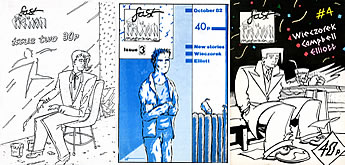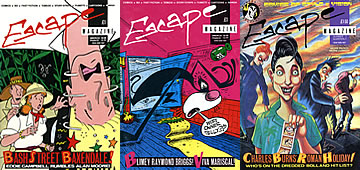British Comics:
A Cultural History
On March 20th 2012, The Royal Mail will release this set of ten stamps celebrating 75 years of British comics to mark The Dandy’s 75th birthday. Here’s my review of a new study on the subject by James Chapman, British Comics: A Cultural History. There is also a small free exhibition in five display cases about British Comics at the Victoria & Albert Museum in Room 74 until May 27th entitled On Eagle’s Wings: British Adventure Comics 1950-1969.

As I found when compiling the book Great British Comics back in 2006, British comics is a vast landscape which any single volume would struggle to map out fully and whose boundaries easily blur, most notably with the American comic book industry. The problem is that, the same few comics, characters and creators have kept getting the lion’s share of the analysis leaving huge areas languishing. Aside from the works of Martin Barker and Roger Sabin, James Chapman, author of British Comics: A Cultural History, rightly points out the paucity of scholarly research until now into British comics, which lags behind America or France and Belgium for example. Coming from Film Studies, Chapman sets out “...to analyse what comics tells us about their producers, their readers, and their society and culture”, on the understanding that popular culture “... is both a product of social processes and that it also plays a role in constructing social values.” Wisely, he narrows his focus, concentrating on periodical comics, especially of the boys’ adventure variety. He confines the subject still further by choosing to omit newspaper strips and graphic novels, although he devotes seven copiously illustrated pages to the Daily Mirror‘s morale- and libido-boosting heroine Jane, and delves into Alan Moore’s From Hell and League of Extraordinary Gentlemen epics, among others.

In terms of time period, the opening chapter sweeps through swathes of history, swiftly cutting from William Hogarth to the start of Punch in 1841, and then through a century to Jane and her World War Two propaganda role. Along the way, Ally Sloper, shown above in a Christmas print by William Fletcher Thomas, is given some closer attention as a revealing reflection of Victorian values, but Chapman concedes here that the vast production from this period remains under-researched and brings relatively little fresh insights to light here. One mine of information awaiting excavation may well be the Denis Gifford Collection held by the Special Collections Unit of the British Film Institute, which Chapman has delved into. Chapman does incorporate a survey of 1,570 boys and 1,330 girls by Augustus Jenkinson in 1938 and usefully summarises its findings. One wonders however if it is possible to find more than anecdotal evidence of comics’ popularity and reception in the past. Surely there is still some time left to interview senior readers about their childhood memories of reading comics.
What Chapman does better over the remaining nine chapters is to bring together diverse existing research into more tightly argued and themed narratives. The whole second chapter plunges into the much-investigated Eagle, but usefully begins by setting the cultural climate of the moral panic about ‘horror comics’ which engendered the new British weekly launched in 1950. It is intriguing to read about Churchill, Prime Minister at the time, asking to see and being shown issues of American comic books, or more accurately their British reprints, mostly in black-and-white. Chapman has delved into a memo from Churchill’s private secretary hinting strongly that his only real interest was the notion that D.C. Thomson were distributing these titles and therefore could be criticised, if not pilloried, for doing so. Churchill held a grudge against Thomson whose campaign against him lost him his seat as Liberal MP for Dundee in 1922. Chapman notes, :“However, Churchill’s interest seems to have waned when he was told that Thomson was not responsible for these particular comics.” There are other fascinating nuggets such as the 1947 Mass-Observation study which discovered that comics “...are almost automatic reading matter for children except where there is a parental ban.”

In rightly praising Frank Hampson’s Dan Dare, Chapman overstates how he “pioneered a ‘filmic’ style of drawing comic strips”. In Britain, Reg Perrott for one in Mickey Mouse Weekly (see extract above from Puck in 1937) was a true innovator in the UK as far back at the mid-Thirties. In fact, Mickey Mouse Weekly is under-represented here with only one citing, perhaps on the mistaken assumption that it was an American imported title, when in fact in its early years much if not most of it was British in origin. The National Art Library of the V&A Museum in London holds an almost complete run, ripe for research, of this pioneering photogravure weekly that predated The Dandy by three years and pioneered modern, balloon-driven children’s comics in the UK. Branching off from Dan Dare, Chapman compares and contrasts two other British Fifties space heroes, Rick Random from Super Detective Library, and another newspaper strip, Jeff Hawke in the Daily Express.

The post-Second World War boom in western, historical, sports and above all war adventures for boys, much of it rooted in the imperial fiction of the earlier boys’ story papers, is clearly set in its shifting cultural contexts in the third chapter. Notable omissions include Look & Learn‘s Trigan Empire. Chapman’s admitted personal interests, however, end up reducing the vast arena of girls’ (and women’s) comics to a single chapter, the fourth and shortest in the book, spanning from School Friend to Misty. Some might not agree with his conclusion that, “Henceforth, with occasional exceptions such as the Barbie comic for young girls that appeared in the 1990s, the British comic has been a predominantly adult and male affair”.

From Chapter Five onwards, we are in familiar territories, from the well-worn controversies of Battle, Action and 2000AD to the British take on superheroes from Marvelman to Jack Staff. To organise these histories, Chapman decides to sidestep strict chronology and separate trends, genres or markets. So he classifies adult underground comics, from Cyclops and Nasty Tales (above) to Escape and Viz, under the umbrella of alternative comics and distinguishes them from such other adult comics magazines as Warrior, Deadline and Crisis. To declare my personal interest, I am chuffed when the British small press scene and Escape magazine of the Eighties, which I co-founded and co-published with Peter Stanbury, are acknowledged, as here. I was quietly amused to see the term ‘Fast Fiction’, which I borrowed from an old Overstreet American Comic Book Price Guide as the title of a largely forgotten, short-lived American imitator of Classics Illustrated, adopted here by Chapman as if it is a widely used ‘genre’. The term was never, as far as I can recall, used by their creators to describe the comics themselves, only the distribution service via the stall at Westminster Central Hall Comic Marts and via mail order. But now it seems the term is being recognised.

Later, Chapman considers Escape succinctly but mostly accurately, although I never “relinquished to Phil Elliott and Ian Wieczorek” the earlier Fast Fiction anthology, as they had originated it and steered it from the start. My only input was shooting the PMTs or photo-mechanical transfers, reduced from their original artwork, made in secret on the weekend at pssst! magazine’s offices to print from. Other minor corrections include John not Jonathan Bagnall, Dave McKean not McKeen, and Escape ran until 1989, not 1990. Whether Chapman has captured the cultural context of these artists and this movement is less clear; instead he goes on to devotes more pages to the rather overly analysed Viz.

Sealing off Escape and Viz from the two waves of sci-fi and then style comics - Graphixus, Near Myths, pssst!, Warrior from 1978-1985, and Heartbreak Hotel, Crisis, Deadline, Revolver, Strip and others from 1988 to 1991, all aimed more or less at adults - is one way to organise this history under the heading ‘The Growing Pains of British Comics’. But this artificial segregation cuts both titles off from their actual close interrelationships with these other magazines. Escape, for one, sprang literally out of pssst! (which is variously misspelt here as psst!). Segmenting comics history in this hermetic way risks losing sight of the more complex, interdependent histories between sectors, creators and publishers, copying or rejecting each others’ approaches and rarely operating in isolation, culturally or commercially.
The tenth and final chapter heralds ‘The British Comics Renaissance’, no longer a mass medium but now getting some credibility. By focussing on the high-profile adult market, he underplays the questions of why sales to children plummeted in the Nineties, a generation lost to computer games due to the ineptitude of the corporate publishers. He also fails to address the recent weekly The DFC and its resurrection this year as The Phoenix. Instead, he harks back to Eagle and Commando, by concluding with Garth Ennis’s scripts for modern, critical adult war comics and his reworking of Dan Dare as “a commentary on the resurgence of the Far Right in early twenty-first century Britain”. This does bring a certain neat circularity to his history but does not address capably enough the many other current comics being conceived if not published in Britain.

Don’t be put off by this book’s “stock-photo”, retro-distressed, red-white-and-blue cover of a faintly phallic rocket ship. British Comics: A Cultural History stands as a solid distillation of at least some of the better known titles and heroes (and far fewer heroines) and the creators and publishers, mainly men, behind them. Chapman has done some investigation himself. In listing his sources, as well as the vital primary sources of the comics themselves, Chapman refers to some collections of papers and archives, though it is frustrating to scholars that the company records of D.C. Thomson and Amalgamated Press/IPC remain inaccessible. It seems that Chapman made little use, however, of those other primary sources, the people still alive who made and are making these comics. As far as I can tell, all the quotations he cites are taken from other people’s previous interviews. While he acknowledges key texts, including my own survey Great British Comics, he surprisingly omits from the Sources appendix Dave Huxley’s Nasty Tales underground comics history from Headpress, Graham Kibble-White’s The Ultimate Book of British Comics, and the two Frank Hampson biographies by Alastair Crompton and Daniel Tatarsky.
Chapman’s final understatement is that British comics as social practice is “a subject in need of further research”. His first attempt to chart this cultural history might have been a more ground-breaking study, if he had brought in a few more insights from original research of his own and explored some less well-trodden paths in this expansive field. Hopefully those paths will entice other scholars to explore them and report back their findings.
Posted: February 5, 2012This review originally appeared in Studies in Comics Volume 2 Number 2, 2012.















